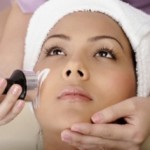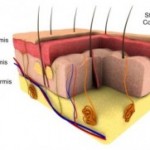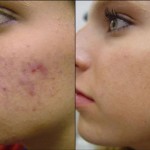Microdermabrasion and Acne?
#Microdermabrasion and Acne, Microdermabrasion is a process in which tiny rough grains or crystals are used to buff away the surface layer of the skin. Microdermabrasion actually targets the outermost layer of the skin (the stratum corneum) where the superficial acne scars reside.
Before understanding what microdermabrasion can do to reduce your acne scarring, it is important that you initially understand the structure of the outer layers of skin- the epidermis and the dermis.
Your Skin
The Epidermis
 The epidermis is the outermost layer of your skin. Its thickness varies from 0.05mm to 1.5mm according to its location on your body. It is made up of dead skin cells on top of maturing skin cells. The layer of dead skin cells is called the STRATUM CORNEUM. This layer is somewhat permeable and allows moisture from creams and lotions to pass through it.
The epidermis is the outermost layer of your skin. Its thickness varies from 0.05mm to 1.5mm according to its location on your body. It is made up of dead skin cells on top of maturing skin cells. The layer of dead skin cells is called the STRATUM CORNEUM. This layer is somewhat permeable and allows moisture from creams and lotions to pass through it.
It is within this layer that minor imperfections, such as acne blemishes and wrinkle lines occur.
The Dermis
The dermis is the layer of skin below the epidermis. This layer also varies in thickness according to its location on the body- 0.3mm to3.0mm.
The dermis is composed of 3 types of tissue:-
- Collagen
- Elastic Tissue
- Reticular fibers
The upper layer of the dermis called the papillary layer contains a thin arrangement of collagen fibers. The lower layer of the dermis called the reticular layer, is thicker than the papillary layer and is made of thicker collagen fibers.
It is within the dermis that hair follicles and sebaceous glands reside. Nerves that transmit the sensations of pain, itch, temperature, touch and pressure are also found in this layer of skin.
What causes acne?
Now that you have a better understanding of human skin structure, you will be able to quickly comprehend what causes acne.
Hormonal changes
During puberty, or times of stress, adrenal glands produce increased levels of hormones; and this in turn causes enlargement of the sebaceous glands, also known as “oil glands”. The increased hormonal levels also lead to stimulation of the sebaceous glands to produce more oil (also known as sebum). This oil then flows to the surface of the skin forming pimples.
Inflammation
Skin inflammation occurs when the body’s immune system acts to get rid of foreign substances. Pimples are formed when oil, dead skin cells and bacteria from the surface of the skin enter the skin. This irritates the skin and forms small inflamed areas. Inflamed skin is usually characterized by swelling, redness and discomfort.
Will microdermabrasion remove your acne scars?
[highlight color=”yellow”]Microdermabrasion is recommended for patients with mild acne scarring[/highlight] . It is  not effective on deep acne scars . After about 6 microdermabrasion procedures one will see improvement to the overall complexion of the face, and mild imperfections will be removed.
not effective on deep acne scars . After about 6 microdermabrasion procedures one will see improvement to the overall complexion of the face, and mild imperfections will be removed.
If one wishes to improve scarring deeper than 10-15 microns, dermabrasion is recommended instead of microdermabrasion. Dermabrasion improves deep wrinkles, scars, legions and hyperpigmentation.
People usually opt for microdermabrasion however, because the recovery time is shorter, it is a more convenient procedure and it is much less expensive. Also, microdermabrasion kits are now also available for home-use.
What are the side-effects of microdermabrasion?
- Thinner skin
- Redness
- Flaking
- Itching
- Dry skin
What is the cost of Microdermabrasion?
In my studio starting at $75
In doctor’s offices, beauty centers and spas, microdermabrasion costs around $150 to $300 per procedure. A minimum of 10 procedures is usually recommended for noticeable results to be seen. microdermabrasion and acne.
- Microdermabrasion Acne – Jordan Heffron on HubPages – Microdermabrasion for acne is a specific treatment for acne that is able to get rid of acne scars on the surface of your skin. This method of treatment for acne is …